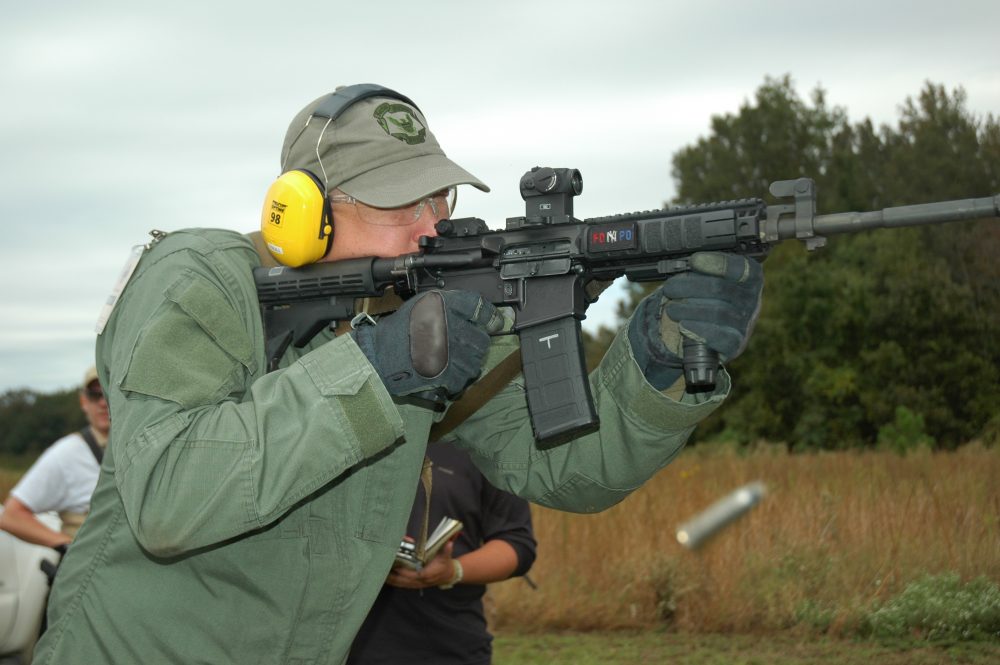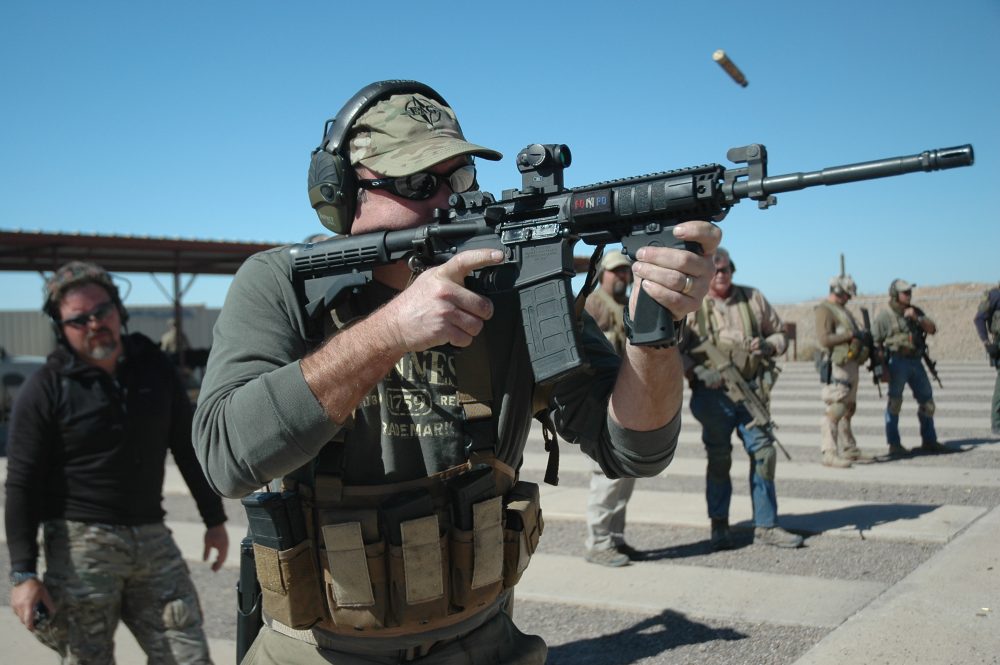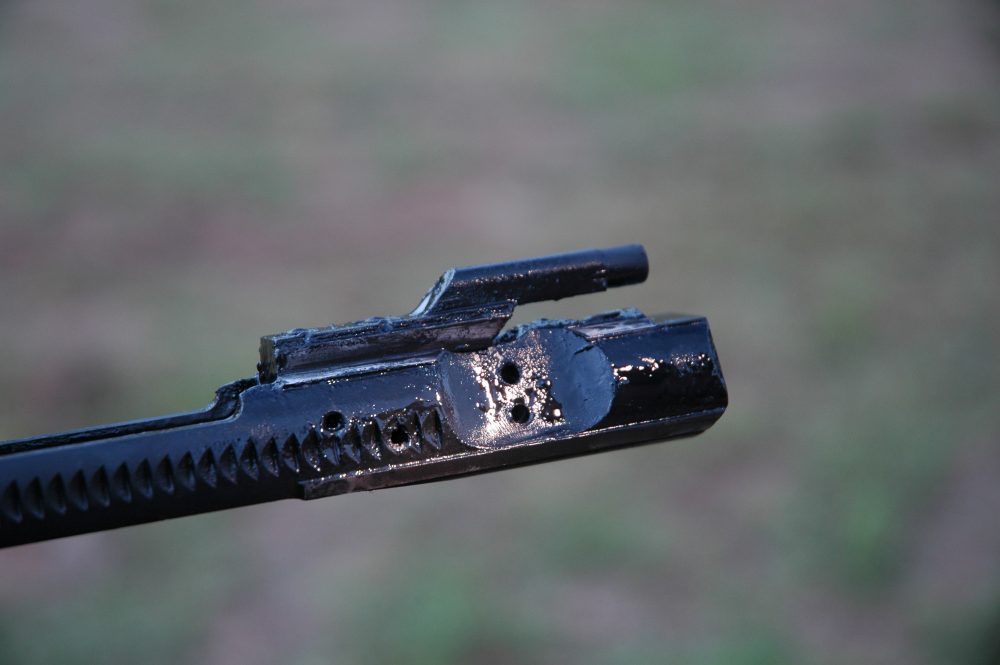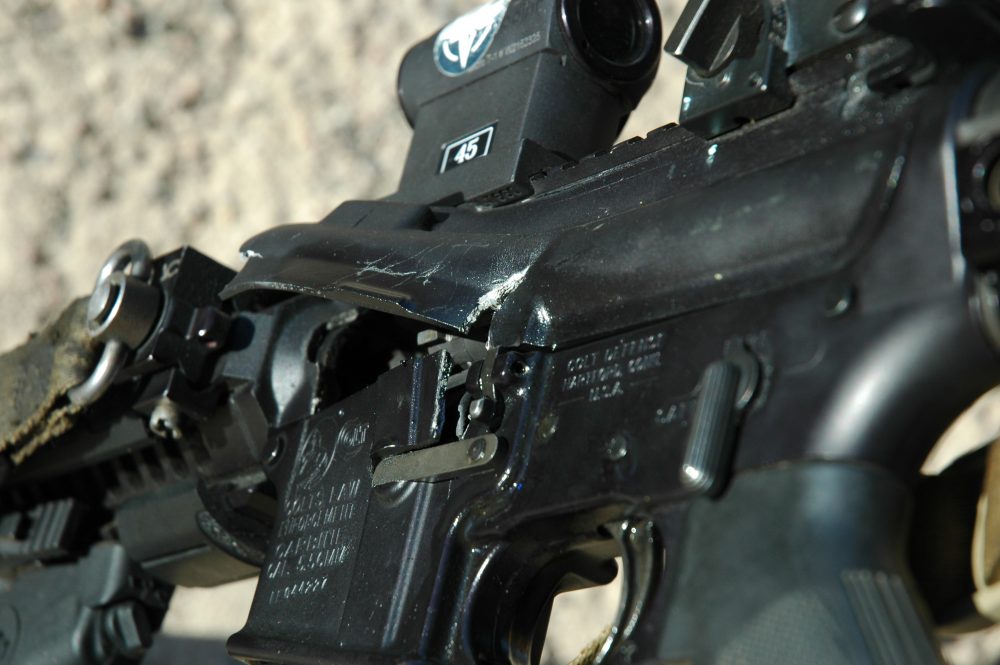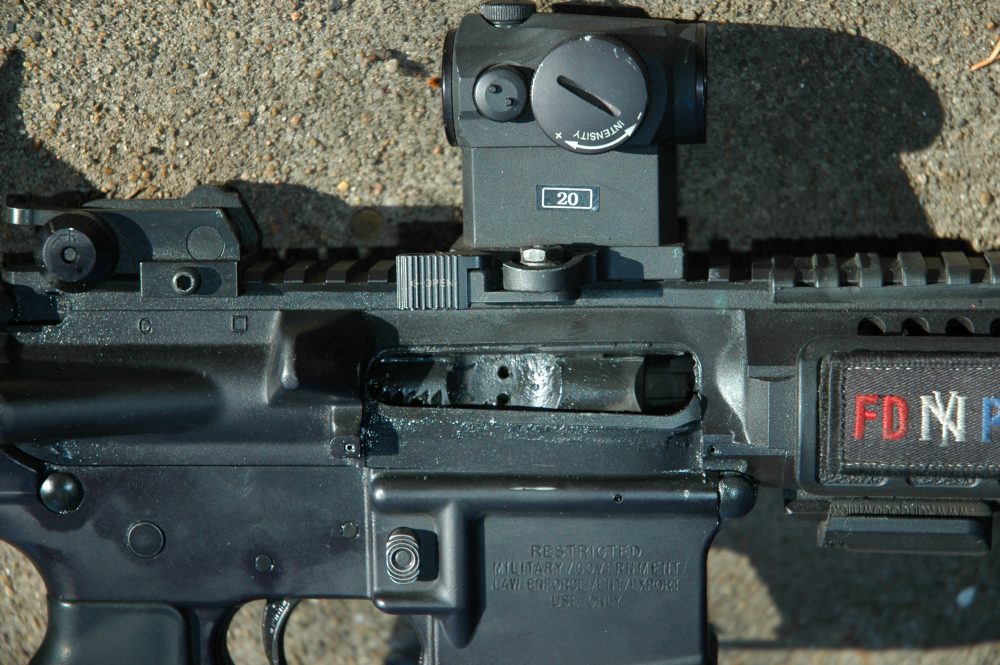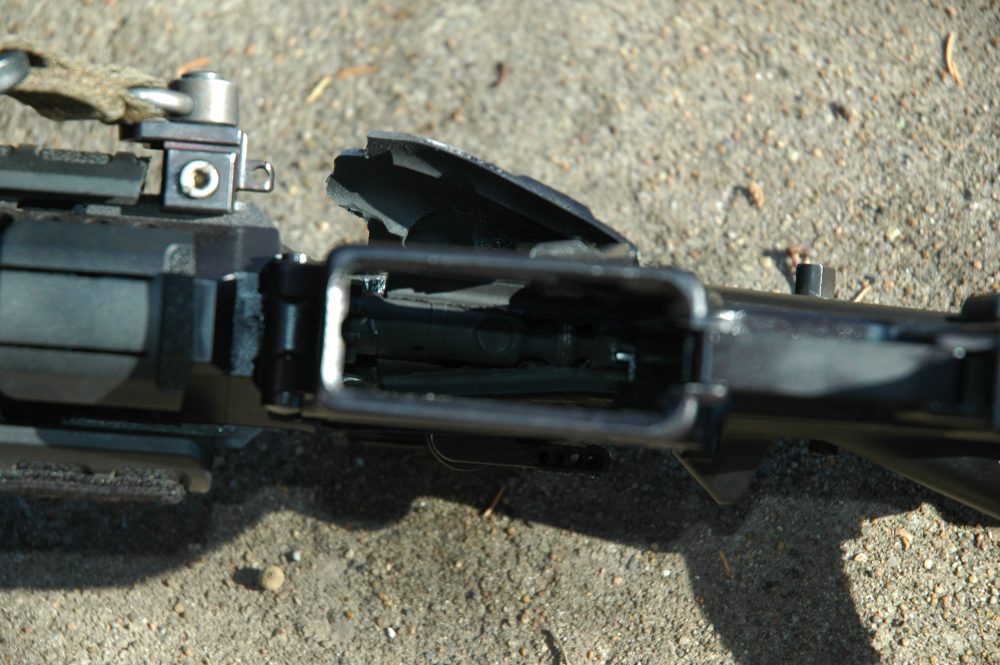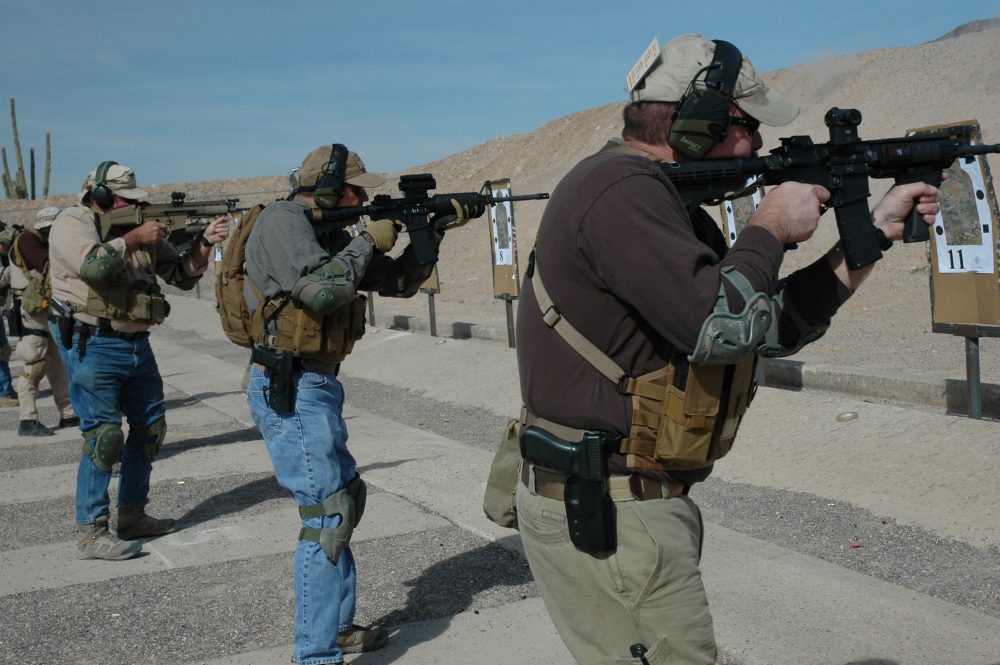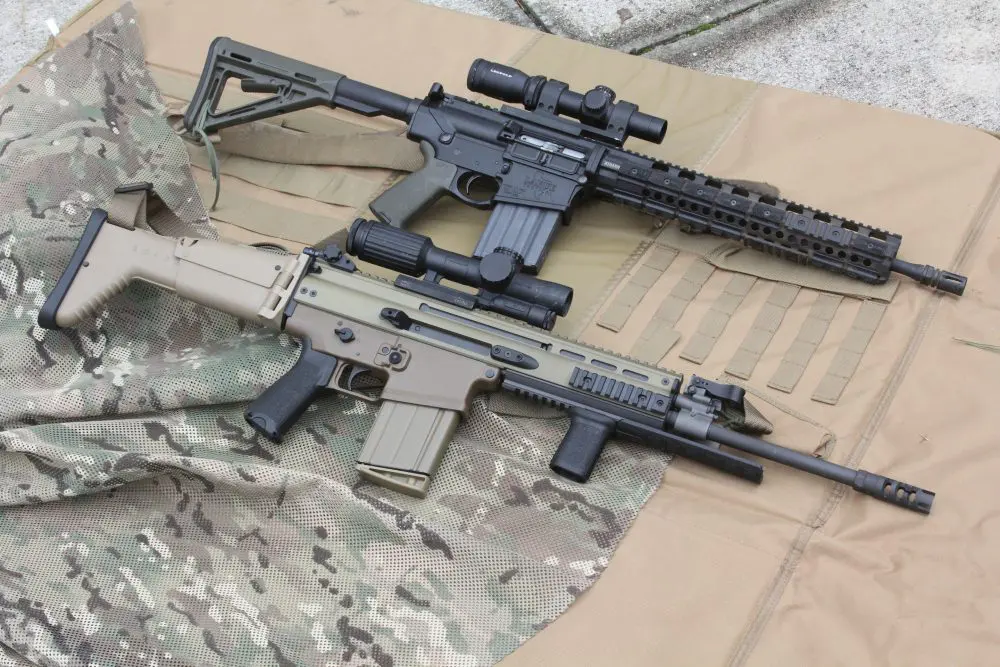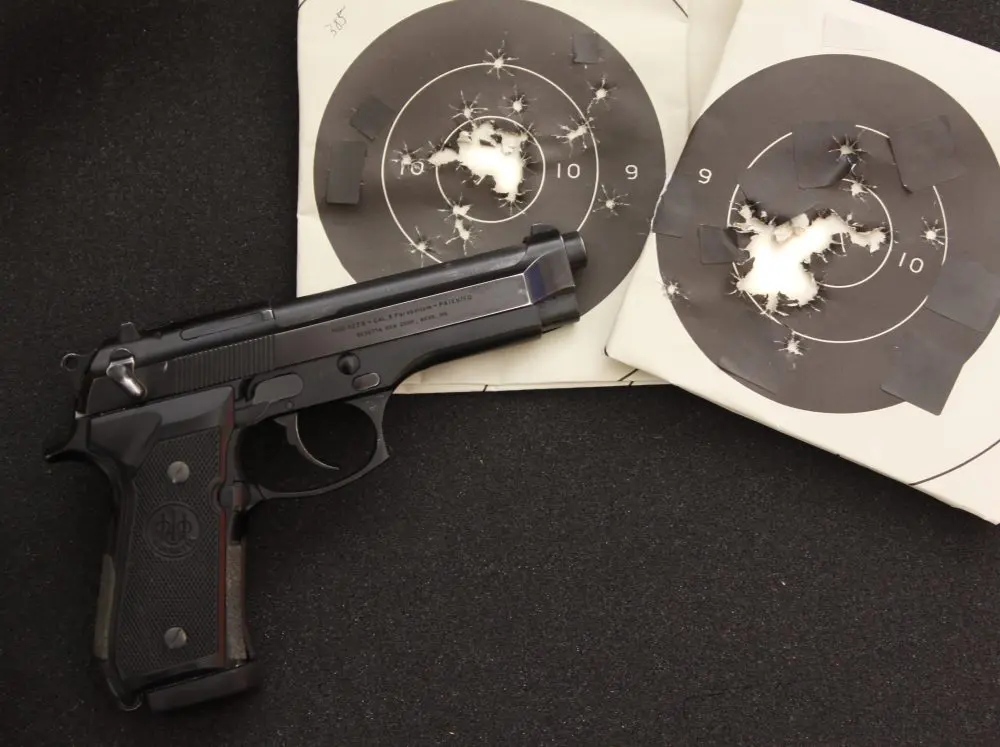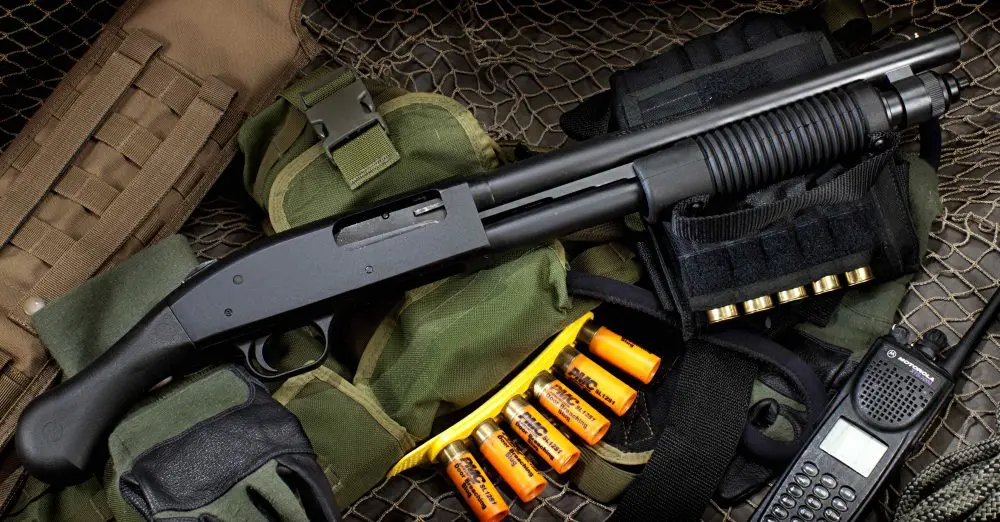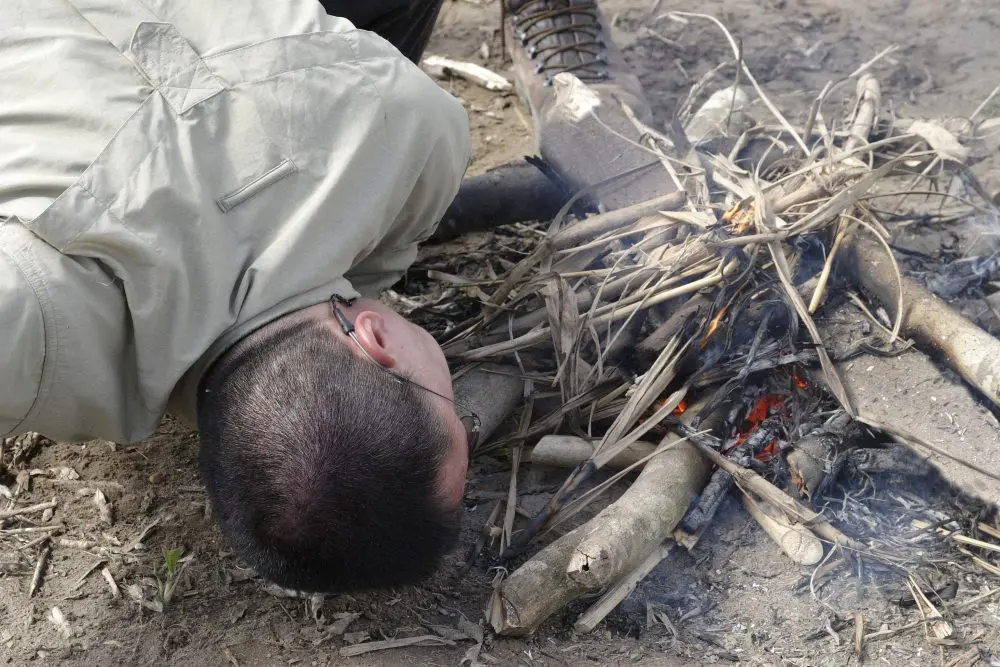Hard-shooting North Carolina cop runs 6940 at Howell Woods class, October 2009.
EAG Tactical first received the Colt 6940 in January 2009 and I wrote an introductory article about the carbine (CLIFFHANGER: Colt LE6940 Advanced Law Enforcement Carbine, June 2009, S.W.A.T.).
Our evaluation protocol is to get a fair number of rounds downrange on several guns of the same model in order to get a decent idea of how others might perform. However, that was not going to happen here, so we figured we would do the best we could with one gun.
We generally equip our T&E guns with an Aimpoint sight on a LaRue mount, a TangoDown PR-4 sling swivel and a Viking Tactics VTAC sling. We normally place a TangoDown Vertical Foregrip on the gun, but Colt advised that we would receive a LaserMax Colt CGL Foregrip Laser System. Unfortunately, the CGL didn’t show up until late into the evaluation period, so we used the TangoDown VFG for the majority of the testing.
The CGLR/L is housed in a vertical foregrip that requires a hold the Magpul Dynamics guys call (appropriately) vertical foregrip. This requires the user to wrap all five fingers around the CGLR/L to operate the visible laser or the so-called traveling light. This type of grip was common in the recent past, but the thumb break method has overtaken the vertical foregrip method, and for cause. There is more control over the gun using the thumb break, especially when engaging multiple targets.
At Casa Grande, Arizona, Police Range, shooter with 6940 is in first stage of a drill. He has fired five rounds standing and will execute a speed reload. His trigger finger is straight as he prepares to execute the speed reload.
Some are dispensing with the VFG altogether and holding the carbine toward the end of the rail. Add to this the fact that a visible laser has a somewhat limited use. There are, to be sure, a training benefit and several operational benefits. However, we don’t have the time built in to our Carbine Operators Course to cover visible lasers. As a result, this item was seldom used, and most did not like the M16-style pistol grip as a vertical foregrip.
We believe that the top rail is a much better place to mount a visible laser/IR laser, and this is the most common place for these units.
To be fair, the CGLR/L was rugged and maintained zero during infrequent checks.
The one item that we add to all T&E guns is the Bravo Company Gunfighter Charging Handle. While we never did get around to doing that on this carbine, it is interesting to note that Colt had them on their display guns at the 2010 SHOT Show.
The 6940 is a monolithic rail system: the upper receiver and the rail are made from a single piece of aluminum. This means that it is a free-float rail and potentially stronger than some add-on rails, but we have no hard data on that. It makes the decision-making process on purchases easier (consider department purchases here), as the rail is already included in the purchase price, and additional purchase orders and time/expense to install aftermarket rails are eliminated. A downside is that if the rail is damaged, the entire upper needs to be replaced.
Bolt of 6940 at 15,600 rounds without cleaning. We use only SLiP2000 EWL to lube our guns, and apply it generously. So much for the M16 FOW needing to be white glove clean to work…
Another negative voiced by some concerning the 6940 rail is that it is carbine length (7″) with a proprietary folding front sight. Some feel that, as there is no fixed sight base, the rail should have been 9″ to accommodate additional shooting styles as well as additional mission-essential equipment. For the majority of end users, however, the 7″ rail will be sufficient.
We were hoping to get 10,000 rounds downrange in this gun, but exceeded that amount early on because the gun was popular with students. At approximately 15,000 rounds, Colt called and asked for their gun back, but when we spoke to Chris Bartocci at Colt and advised that we had 15,000 trouble-free rounds downrange without cleaning, he told us to continue running the gun until the end of the year. When I told him that we might clean it as it was getting grungy, he told us to keep running it because it was good data for the engineers.
Lower receiver was fractured in several places. Upper receiver was peeled back. We believe LaRue Tactical 660 Aimpoint Mount prevented fracture from going completely around Mil-Std-1913 Rail. We were able to get LaRue mount off with some nifty nylon mallet work. There was some damage to underside of mount. T1 still works, and both T1 and mount are on 6940’s successor, a BCM Mid Length. They still maintain zero.
As a rule, we won’t clean a T&E gun during the evaluation period. Instead, we lube it generously with SLiP2000 Extreme Weapons Lubricant (EWL) regularly. Cleaning occurs if environmental situations demand it or if parts need to be exchanged. We know that a quality AR will run when clean and lubricated. We also know that the AR Family of Weapons (FOW) does not need to be meticulously cleaned, but does need to be properly lubricated.
At the very next EAG class, at Howell Woods, North Carolina, in early October 2009, with approximately 15,600 rounds downrange, we had some failures to extract. Out host, Sgt. Jeff Frueler of the North Carolina Highway Patrol, removed the gun from the line and changed the extractor and extractor spring. In order to do this, he gave the gun a field cleaning—the first this gun had seen. We put it back in service and it ran as advertised.
Maintenance schedules are nebulous, and few will recommend replacement schedules, for a variety of reasons, instead running the gun until a part needs replacement. A rule of thumb might be to change the extractor spring at 5,000-7,000 rounds and the extractor at 10,000 rounds. Considering this, having the extractor and spring fail at this point can be considered nothing more than normal wear.
Typically we’ll see bolts on 16″ guns start to fail at approximately 15,000 rounds, with lugs cracking the most common problem.
Upper receiver was bulged and cracked at ejection port.
At the Casa Grande, Arizona, class in late October 2009, the volunteer shooter had several failures to feed. As we were in the middle of a string of fire, I exchanged the 6940 with my Bravo Company carbine in order for him to be able to continue the drill. At this point the gun had approximately 17,600 rounds downrange.
Mike Hueser, my assistant instructor, took the 6940 offline in order to ascertain the problem and repair as necessary.
A few minutes later, during a second string of fire, I became aware of a disturbance on the end of the line. Calling a ceasefire, I went up to find Mike surrounded by a wreath of smoke, looking at the 6940 and stating, “The (expletive deleted) rifle blew up.” Mike, the master of understatement!
Mike received some minor wounds to the arm and neck.
The 6940’s upper receiver on the left side was peeled back and a 1.75″x3.25″ flap curled up at about a 40 degree angle. There was a crack at the top of the upper receiver at the Picatinny Rail.
It appears that the LaRue Tactical 660 Mount (holding the Aimpoint T1) may have prevented the crack from propagating further. It took awhile before we could pound the LaRue mount off. While there was some damage, both the Aimpoint and the LaRue mount are residing on the Bravo Company gun that replaced the 6940. They both still work, and still hold zero.
There was a damaged round protruding out of the left side of the receiver.
Mag well does not appear to be bulged. Bolt carrier was peeled back and lower portion was driven into top of magazine, unlocking it and spreading upper part of magazine against mag well.
The TangoDown ARC magazine was forced down approximately .75″ and wedged into the mag well. It had a crack approximately 2.625″ in the right side of the body. The upper portion of the magazine bulged outward and was stuck in the mag well.
The right side of the upper receiver was fractured at the front lower edge. The extractor pin was broken, and the extractor (recovered approximately six feet away) was bent. The case of the chambered round was ripped apart, and the base remained on the bolt face. It was not possible to determine a headstamp. The ejection port cover went into next week. We never did find it.
The lower receiver had a vertical crack on the left side, just forward of the bolt catch. The mag well was not bulged as we have seen in other incidents.
Mike used one of my magazines to see if he could duplicate the stoppages. I do not use steel-cased ammo, nor do I use reloads. I buy my ammunition in bulk, and while Black Hills is my standard, I will also use other brands as we can procure the ammunition for class. I am also not anal about the ammo used at class. I segregate ammunition into training and anti-personnel as well as projectile weight.
At the end of class, I will charge the expended/partially expended magazines with whatever ammunition I have on hand or is next in the lineup. I do pay strict attention to my Force Protection ammunition, but for shooting at 50 yards and in, I’ll use any 55-grain ammo that is in the armory. The bottom line is that I have no clue what brand of ammunition was in that magazine when the gun went high order.
My experience has been that the majority of catastrophic weapons failures can be attributed to ammunition. This may come from squib loads, where an undercharged round may put a bullet into the barrel. A second round may be fired into it, causing an overpressure situation.
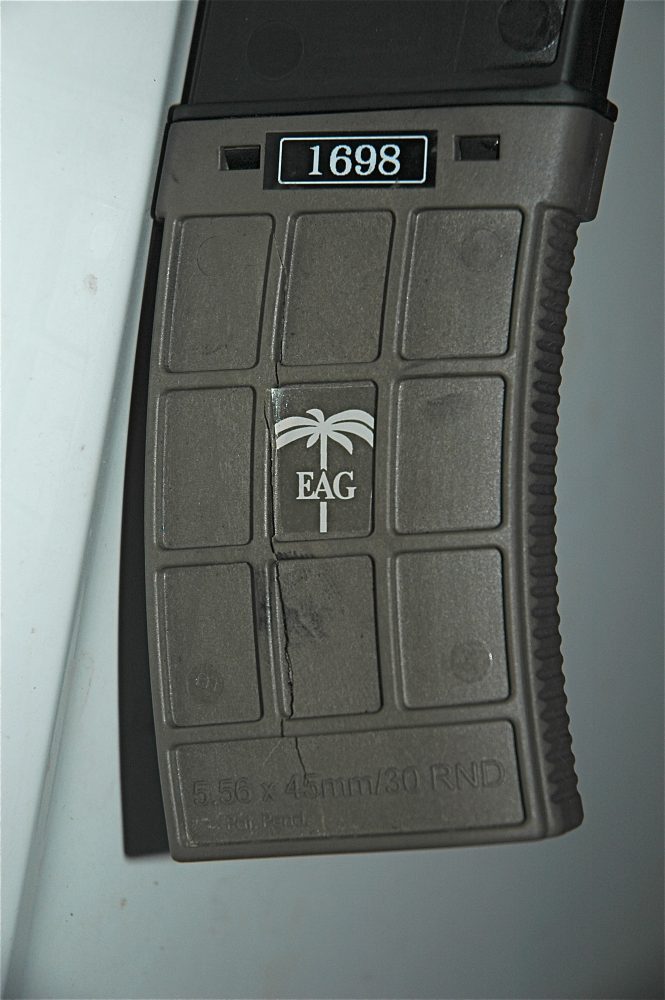
In every case that we have seen, the projectiles have remained in the barrel and the pressure has vented out the path of least resistance—the extractor, magazine and, if the bolt unlocks, the upper receiver. Meanwhile, the bolt and barrel have remained intact. This is a tribute not only to former USMC Cpl Eugene Stoner’s genius in design, but also to the Quality Control/Quality Assurance (QC/QA) at the factory.
In every case, the bolt and barrel remained intact and the bolt carrier fractured. The upper receiver fractured, sometimes into multiple pieces. The lower receiver bulged around the magazine well and, in some cases, fractured at the barrel extension.
The shooter was always uninjured or received minor injuries. Most of the gas goes forward/downward and off to the sides, as do the frags.
Usually there are some minor frag injuries to the support-side arm, regardless of your hand position or shooting style. Some frags/gas may be vented rearward, one of many reasons why you should always have some type of eye protection whenever you press a trigger. Those who choose not to wear eyepro are fools.
And every time I see one of these, I wonder why anyone would use a bullpup.
We packaged the gun up and sent it back to Colt immediately after the incident. Though we have requested their findings several times, we have not received any information. Large companies are often not as responsive as smaller companies, because they have larger filters when information passes from one level to another.
Remember that any firearm is a single shot away from deconstructing. No matter if that particular gun is built to a mil standard or is made from gun show parts and assembled on a kitchen table, circumstances as simple as a single cartridge loaded with the wrong powder, a blend of powders, over charged or not charged at all may be the start of a very loud noise.
Over the years, we have seen this happen to a number of guns, and I had the unpleasant experience of having an M4A1 go full order while I was shooting it. On another occasion, I was standing on the right side of a shooter when his Mk 18 let go. It is by no means common, but it happens.
CONCLUSIONS
The spectacular end to the evaluation aside, the Colt 6940 was a popular gun with the students. Up until the extractor/spring wore at approximately 15,600 rounds, we did not have a single gun-related stoppage. After that, the carbine ran smoothly until the failures immediately prior to the event.
Many students liked the idea of the monolithic rail. They felt that this would make purchasing a carbine easier, as the issues of which rail to use, installation and cost factors would be reduced.
On the other side, some felt that, as long as there was a folding front sight, the rail should have been 9″ vice the carbine length of 7″. They felt that the added length would give them added real estate for mission-essential equipment as well as options in using different hand positions to enhance controllability.
CLG requires full vertical foregrip hold. Many people are using other techniques now.
I will admit to having a Colt bias, just as I have a bias for Bravo Company Manufacturing, LaRue Tactical, Lewis Machine & Tool, Noveske, Defensive Edge, LWRCI and Smith & Wesson. That is based on having multiple examples of each with many thousands of rounds through each example. Guns built to a standard will generally perform to a standard.
Bear in mind that, while quality ammunition will likewise perform to a higher standard, anomalies can occur.
[Pat Rogers is a retired Chief Warrant Officer of Marines and a retired NYPD Sergeant. Pat is the owner of E.A.G. Inc., which provides services to governmental organizations and private citizens. He can be reached at [email protected].]
SOURCES:
Colt Defense LLC
Dept. S.W.A.T.
P.O. Box 118
Hartford, CT 06141
(800) 241-2485
www.colt.com
Aimpoint Inc.
Dept. S.W.A.T.
14103 Mariah Court
Chantilly, VA 20151-2113
(877) 246-7646
www.aimpoint.com
LaRue Tactical
Dept. S.W.A.T.
850 County Road 177
Leander, TX 78641
(512) 259-1585
www.laruetactical.com
TangoDown
Dept. S.W.A.T.
1588 Arrow Highway, Unit F
La Verne, CA 91750-5334
(520) 888-3376
www.tangodown.com
Viking Tactics, Inc.
Dept. S.W.A.T.
3725 Heatherbrooke Drive
Fayetteville, NC 28306
(910) 987-5983
www.vikingtactics.com
